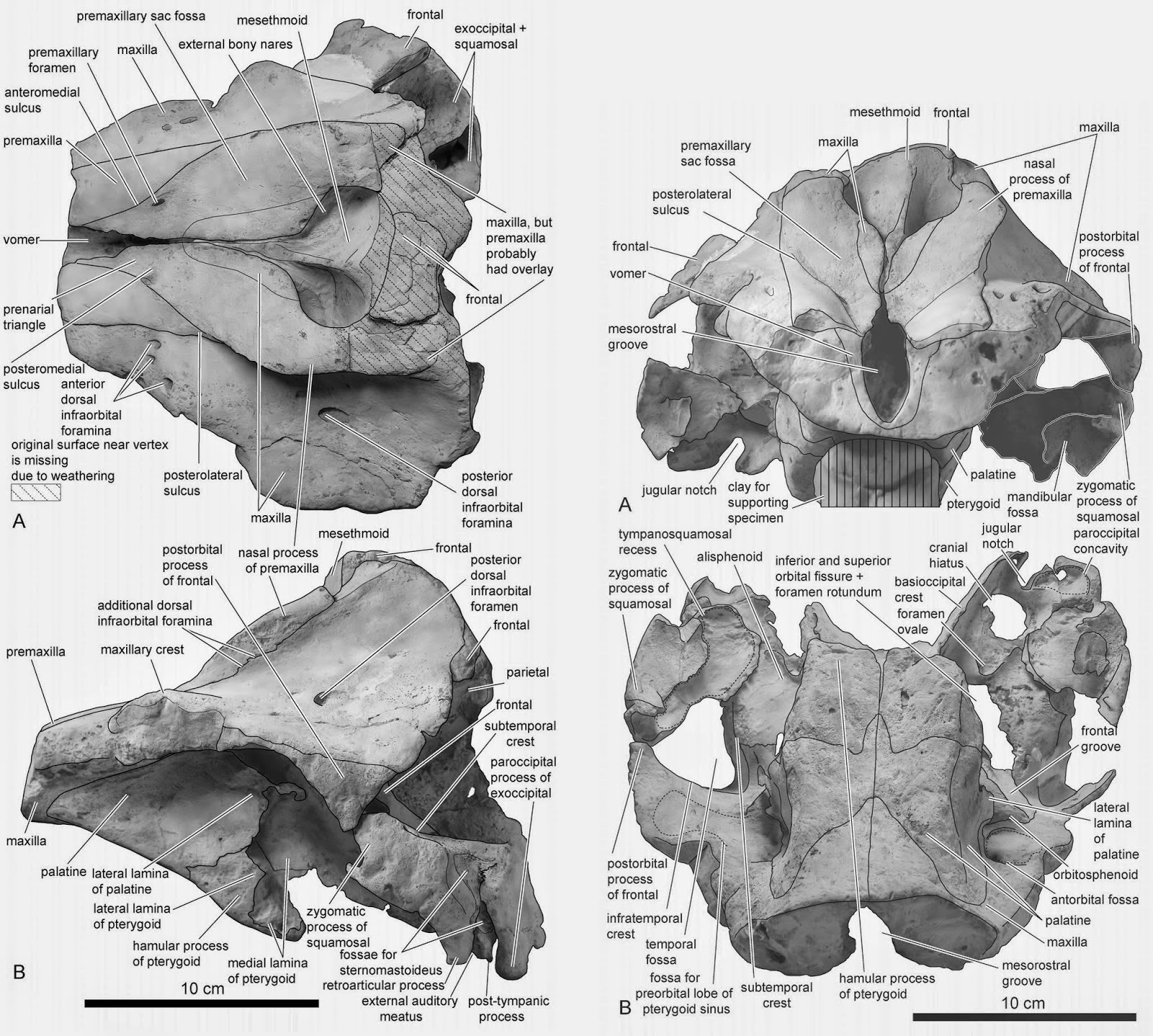Porpoises, Phocoenidae, are small Dolphins, Delphinida, found today
across most of the world’s oceans, but with a fossil record restricted almost
entirely to the North Pacific. Only a single fossil species from outside the
Pacific Basin has been described, Septemtriocetus bosselaersi
from Pliocene sediments at Verrebroek Dock in Antwerp Harbour, Belgium, with a
few isolated bones tentatively assigned to the group from the Miocene of Malta
and the Pliocene of Italy.
In a forthcoming paper in the journal Acta Palaeontologica Polonica
available online from 14 December 2014, Wouter Colpaert of the Research UnitPalaeontology at the Universiteit Gent and Mark Bosselaers and Olivier Lambert
of the Department of Terre et Histoire de la Vie at the Institut royal desSciences naturelles de Belgique, describe a second species of fossil Porpoise
from Antwerp Harbour, collected from the slightly earlier Kattendijk Formation
on the left bank of the River Scheldt at the entrance of the Beveren Tunnel.
The specimen was collected in several fragments by Robert Marquet, a
volunteer palaeontologist at the Institut Royal des Sciences Naturelles de
Belgique. It is named Brabocetus gigasei,
where ‘Brabocetus’ means ‘Brabo’s
Whale’, in reference to SilviusBrabo, the mythical hero who liberated the city
of Antwerp from the giant Antigoon, and ‘gigasei’
honours Paul and Pierre Gigase, a father and son fossil collecting team who
have for many years collected marine Mammal remains from the Antwerp area, and
who donated the specimen to the Institut royal des Sciences naturelles de
Belgique.
The specimen comprises a partial skull in three parts, lacking the
tip of the snout as well as the the nasals, the pterygoids, and some elements
of the cerebral cavity and basicranium as well as part of the left supraorbital
process. The snout appears to have been more elongate than any extant Porpoise
but similar to that seen in Septemtriocetus bosselaersi
as well as in some other extinct Porpoises (Lomacetus,
Piscolithax and probably Salumiphocaena), however unlike in these
species (which are not all closely related) the snout in the two Belgian species
is shorter than the cranium. However Colpaert et al. note that this analysis is based upon a reconstruction of
the missing parts of the skull, and cannot be considered reliable without
additional material being found.
Skull of Brabocetus gigasei,from
the Pliocene of northern Belgium, in dorsal view.Photo (A) and corresponding
line drawing (B). Dotted lines indicate reconstructed parts and poorly visible
structures. Dark grey surfaces indicate fracture surfaces. Light grey surface
indicates the original position of the lost right nasal. Scale bar is 50 mm. Colpaert et al. (2014).
A phylogenetic reconstruction of known members of the Phocoenidae
suggests that while Brabocetus gigaseiis
closely related to Septemtriocetus bosselaersi,
both being members of an extinct group of Porpoises which also includes several
Pacific species, it is not the closest relative of that species, which is more
closely related to five North Pacific species than it is to the new member of
the group. It is not closely related to the modern Harbour Porpoise, Phocoena phocoena, the only modern
Porpoise found in the North Sea.
Consensus tree of the 27 most parsimonious trees,
showing the phylogenetic relationships of Brabocetus gigasei
with other extinct and extant Phocoenids. † indicates extinct taxon. IO, Indian
Ocean; NA, North Atlantic; NP, North Pacific; NS, North Sea; SA, South
Atlantic; SO, southern oceans; SP, South Pacific; 1, 1', and 1'' correspond to
a first trans-Arctic migration scenario with three successive dispersals to the
North Sea. 2, 2', and 2'' correspond to a second scenario with two dispersals
to the North Sea (2, 2'') and a dispersal back to the North Pacific (2'). Colpaert et al. (2014).
This leads to two possible evolutionary scenarios, each of which are
considered equally likely. Either Brabocetus gigasei and Septemtriocetus bosselaersi (or close
ancestors of these species) migrated from the North Pacific to the North Sea
via the Arctic Ocean separately, or the common ancestor of these two species
made a similar migration, with the common ancestor of the more derived members
of the group subsequently migrating back to the North Pacific.
The modern Phocoena phocoena
is thought to have reached the North Sea much later, part of a recent global
expansion which saw members of the group migrate from the North Pacific across
the world’s oceans, and which coincides with a similar global expansion of
other Dolphin groups.
See also…
 A fossil Dolphin from the Late Miocene of Hokkaido, Japan, which may be the oldest True Dolphin. Dolphins, Delphinidae, are the most diverse group of Whales (or
indeed any form of Marine Mammals) alive today, with 36 described species
including charismatic animals such as Bottlenose Dolphins and Killer Whales.
Historically a large number of fossils have also been...
A fossil Dolphin from the Late Miocene of Hokkaido, Japan, which may be the oldest True Dolphin. Dolphins, Delphinidae, are the most diverse group of Whales (or
indeed any form of Marine Mammals) alive today, with 36 described species
including charismatic animals such as Bottlenose Dolphins and Killer Whales.
Historically a large number of fossils have also been...
The Squalodelphinidae are a small group of small to medium-sized
Toothed Whales known from the Miocene of Europe and North and South
America. They are thought to be related to the modern Asian River
Dolphin, Platanista gangetica, which
lacks any close living relatives. The group is not well understood, with most
described specimens being fragmentary in nature.
Porpoises (Phocoenidae) are small Whales, related to Dolphins
(Delphinidae). They tend to have shorter snouts than Dolphins, with
flattened, spade-shaped teeth, as opposed to the conical, pointed teeth
of Dolphins. They are among the smallest and shortest lived Whales,
ranging from 1.2 to 2.3 m in length and typically reaching sexual
maturity at about eight...
Follow Sciency Thoughts on Facebook.




